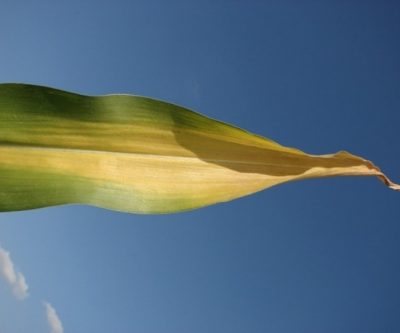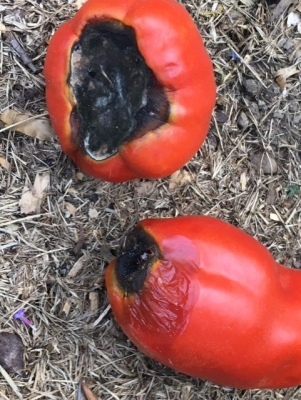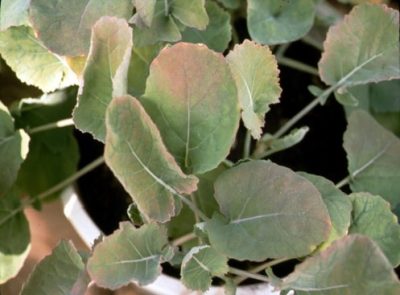Watch Out for These Nutrient Deficiency Symptoms
By Haiying Tao, Ph.D., UConn Home & Garden Education Center
Plants need at least seventeen essential nutrients to complete their life cycles. Scientists group these essential nutrients into macronutrients (carbon, hydrogen, oxygen, nitrogen, potassium, phosphorus, sulfur, calcium and magnesium), which are required in large quantities and micronutrients (zinc, iron, copper, boron, manganese, chlorine, molybdenum and nickel) which are required in small quantities. Sufficient amounts of these nutrients are required in order for plants to produce well. If there is a deficiency of any essential element, yield and quality can be reduced. Alternatively, too much of a nutrient can be toxic to plants. Diagnosing nutrient deficiencies and toxicities is important for both growers and gardeners to ensure optimum harvests.
When low in an essential nutrient, plants exhibit distinct visual symptoms, which often allows us to distinguish which nutrient is deficient. A first step in diagnosing nutrient deficiencies is to describe what the symptoms look like. Symptoms caused by nutrient deficiencies are generally grouped into five categories: 1) stunted growth; 2) chlorosis or yellowing; 3) leaf spots; 4) purplish-red coloring; and 5) necrosis or death of plant parts.
The next step is to identify whether the deficiency symptoms appear on older (lower) leaves or younger (upper) leaves first. If the deficiency symptoms appear on older leaves first, then the deficiency symptoms are possibly caused by one of the nutrients that are mobile in plants, such as nitrogen, phosphorus, potassium, magnesium, chlorine, or molybdenum. In contrast, deficiency of nutrients that are immobile (calcium, sulfur, boron, copper, iron, zinc, manganese, nickel), the symptoms first appear on younger or upper leaves.

Nitrogen deficiency symptoms include yellowing of the lower leaves (chlorosis), stunted and slow growth, and death of older leaves in severe cases. Nitrogen deficient plants will mature early, and the crop quality and yield are often reduced.
Phosphorus deficiency symptoms occur in the older leaves first and typical deficiency symptoms are purpling of leaves and leaf margins and stunted growth. Plants that are deficient in phosphorus are generally weak and maturity is delayed.
Potassium deficiency symptoms first appear on older leaves. Typical deficiency symptoms are yellowing and necrosis of the leaf margins. When potassium deficiency is severe, older leaves turn yellow with brown dead tissue around the edges, but the upper new leaves may stay green. Sometimes one may confuse potassium and nitrogen deficiency because both show yellowing on older (lower) leaves first. The difference is that the chlorosis starts from the tip and progresses along the ribs of the leaf if nitrogen is deficient, but the chlorosis starts from the tip and progresses along the edge of the leaf if potassium is deficient.

Another nutrient that is commonly found deficient is calcium. Typical calcium deficiency symptoms are poor leaf expansion, curling followed by necrotic patches in the young leaves. Calcium deficiency can cause misshapen fruit and aborted buds. If you find the tip of tomatoes or peppers rotting, cavity spot in carrots, and black heart in peanuts and celery, it’s likely the plants are calcium deficient. However, don’t hurry to apply calcium fertilizers. Check on other stresses such as drought because lack of moisture in the soil can lead to insufficient uptake and transportation of calcium within plants, which leads to symptoms similar to calcium deficiency.
In sandy and low organic matter soils, sulfur deficiency can occur. Typical sulfur deficiency symptoms are reduced growth rate with plants becoming stunted and thin stemmed. In cole crops (such as cabbage, broccoli, etc.), discoloration appears in younger leaves first. Symptoms may include light green or yellow leaves, a reddish coloration on the undersides of leaves as well as leaves that are cupped inward.

It is not always easy to identify nutrient deficiencies just by looking at a plant because the symptoms of several deficiencies are similar in appearance. Also, more than one nutrient may be deficient. It is not uncommon for other stresses such as disease, drought, excess water, genetic abnormalities, herbicide and pesticide residue injury, insects or salt injury may cause symptoms that are similar to nutrient deficiency. The best way to confirm if you have nutrient deficiency is to test your soil and plant tissue.
For questions on nutrient management in the garden or farm, feel free to contact the UConn Soil Lab at (860) 486-4271. For all your other gardening questions, contact the UConn Home & Garden Education at (877) 486-6271 or www.homegarden.cahnr,uconn.edu or your local Cooperative Extension Center.
Dr. Tao is an Assistant Professor and Soil Fertility Specialist in the UConn Department of Plant Science & Landscape Architecture.